MITSUBISHI MIRAGE G4 2020 Owner's Manual (in English)
Manufacturer: MITSUBISHI, Model Year: 2020, Model line: MIRAGE G4, Model: MITSUBISHI MIRAGE G4 2020Pages: 253, PDF Size: 36.39 MB
Page 211 of 253
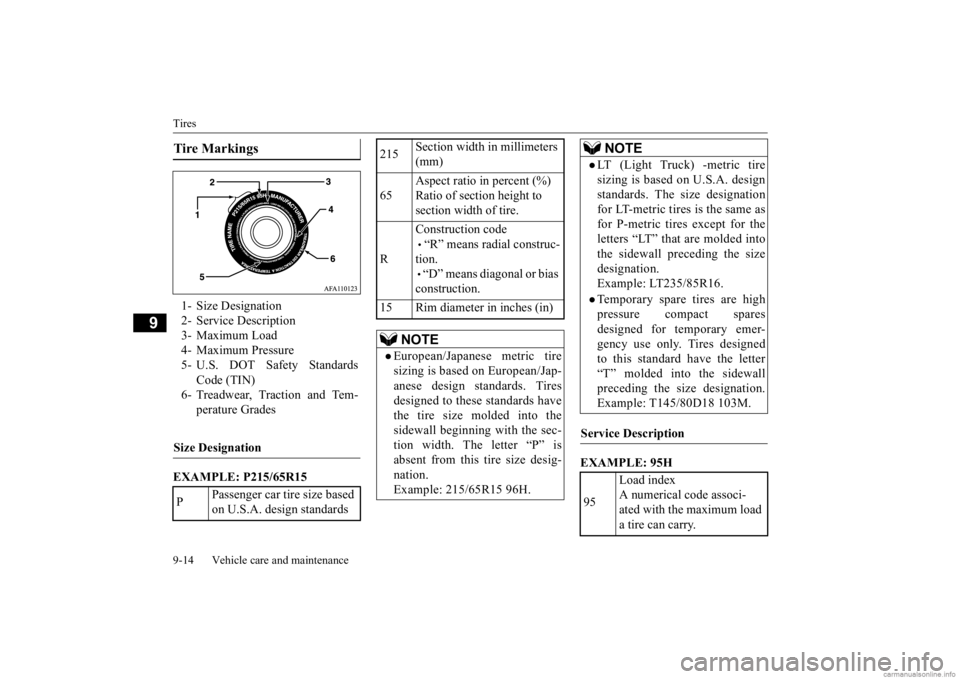
Tires 9-14 Vehicle care and maintenance
9
EXAMPLE: P215/65R15
EXAMPLE: 95H
Tire Markings 1- Size Designation 2- Service Description3- Maximum Load 4- Maximum Pressure 5- U.S. DOT Safety Standards
Code (TIN)
6- Treadwear, Traction and Tem-
perature Grades
Size Designation P
Passenger car tire size based on U.S.A. design standards
215
Section width in millimeters (mm)
65
Aspect ratio in percent (%) Ratio of section height to section width of tire.
R
Construction code • “R” means radial construc- tion. • “D” means diagonal or bias construction.
15 Rim diameter in inches (in)
NOTE
European/Japanese metric tire sizing is based on European/Jap- anese design standards. Tiresdesigned to these standards have the tire size molded into the sidewall beginning with the sec-tion width. The letter “P” is absent from this tire size desig- nation.Example: 215/65R15 96H.
LT (Light Truck) -metric tiresizing is based on U.S.A. design standards. The size designation for LT-metric tires is the same asfor P-metric tires except for the letters “LT” that are molded into the sidewall preceding the sizedesignation. Example: LT235/85R16.Temporary spare tires are highpressure compact spares designed for temporary emer-gency use only. Tires designed to this standard have the letter “T” molded into the sidewallpreceding the si
ze designation.
Example: T145/80D18 103M.
Service Description 95
Load index A numerical code associ- ated with the maximum load a tire can carry.
NOTE
BK0284300US.book 14 ページ 2019年5月23日 木曜日 午後12時22分
Page 212 of 253
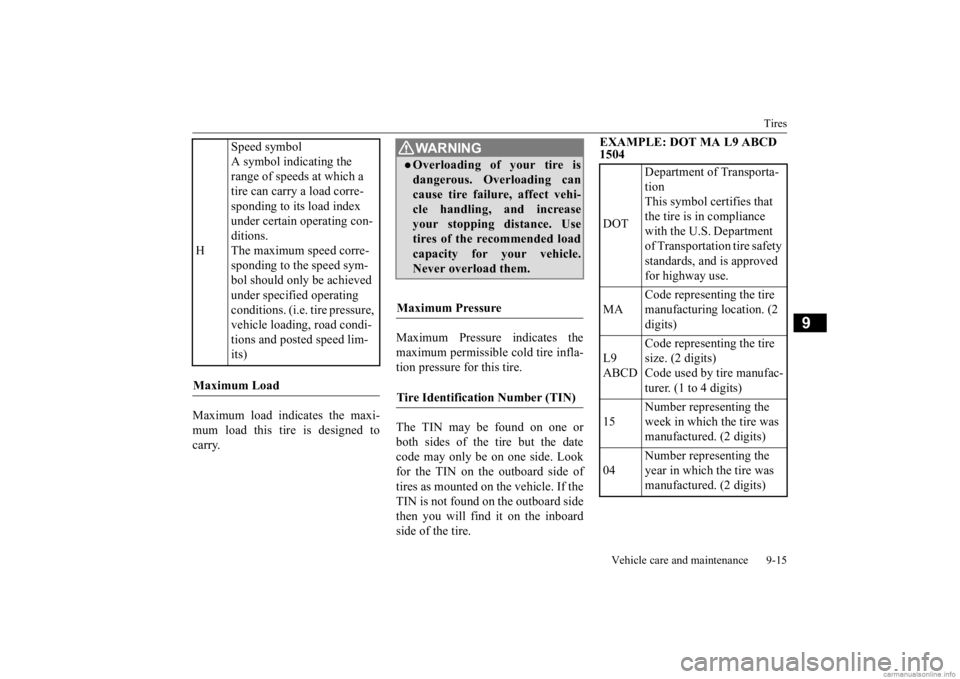
Tires
Vehicle care and maintenance 9-15
9
Maximum load indicates the maxi- mum load this tire is designed to carry.
Maximum Pressure indicates the maximum permissible cold tire infla- tion pressure for this tire. The TIN may be found on one or both sides of the tire but the datecode may only be on one side. Look for the TIN on the outboard side of tires as mounted on the vehicle. If theTIN is not found on the outboard side then you will find it on the inboard side of the tire.
EXAMPLE: DOT MA L9 ABCD 1504
H
Speed symbol A symbol indicating the range of speeds at which a tire can carry a load corre- sponding to its
load index
under certain operating con- ditions. The maximum speed corre-sponding to the speed sym- bol should only be achieved under specified operating conditions. (i.e. tire pressure, vehicle loading, road condi- tions and posted speed lim-its)
Maximum Load
WA R N I N GOverloading of your tire is dangerous. Overloading can cause tire failure, affect vehi- cle handling, and increaseyour stopping distance. Use tires of the recommended load capacity for your vehicle.Never overload them.
Maximum Pressure Tire Identification Number (TIN)
DOT
Department of Transporta- tion This symbol certifies that the tire is in compliance with the U.S.
Department
of Transportation tire safety standards, and is approved for highway use.
MA
Code representing the tire manufacturing location. (2 digits)
L9 ABCD
Code representing the tire size. (2 digits) Code used by tire manufac-turer. (1 to 4 digits)
15
Number representing the week in which
the tire was
manufactured. (2 digits)
04
Number representing the year in which the tire was manufactured. (2 digits)
BK0284300US.book 15 ページ 2019年5月23日 木曜日 午後12時22分
Page 213 of 253

Tires 9-16 Vehicle care and maintenance
9
The treadwear grade is a comparative rating based on the wear rate of thetire when tested under controlled conditions on a specified government test course. For example, a tiregraded 150 would wear one and one- half (1
1/2) times as well on the gov-
ernment course as a tire graded 100. The relative performance of tires depends upon the actual conditionsof their use, however, and may depart significantly from the norm due to variations in driving habits, servicepractices and differences in road characteristic
s and climate.
The traction grades, from highest to lowest, are AA, A, B and C. Those grades represent the tire’s ability to stop on wet pavement as measured
under controlled conditions on speci- fied government test surfaces of asphalt and concrete. A tire marked C may have poor traction perfor-mance. The temperature grades are A (the highest), B and C, representing thetire’s resistance to the generation of heat and its ability to dissipate heat when tested under controlled condi-tions on a specified indoor laboratory test wheel. Sustained high tempera- ture can cause the material of the tireto degenerate and reduce tire life, and excessive temperature can lead to sudden tire failure. The grade C cor-responds to a level of performance which all passenger car tires must meet under the Federal Motor Vehi-cle Safety Standard No. 109. GradesB and A represent higher levels of performance on the laboratory test wheel than the minimum required bylaw.
N00939302037
Proper tire inflation pressure is essential for the safe and satisfactory operation of your vehicle. The wrongtire pressure will cause problems in three major areas:SafetyToo little pressure increases flex- ing in the tire and can cause tirefailure. Too much pressure can cause a tire to lose its ability to cushion shock.
Objects on the
road and potholes could then cause tire damage that may result in tire failure.Economy The wrong tire pressure can cause uneven wear patterns in the tiretread. These abnormal wear pat- terns will reduce the tread life, and the tire will have to be replacedsooner.Too little pressure also makes it harder for the tire to roll, and this uses up more fuel.
Treadwear, Traction and Temper- ature Grades Treadwear Tr a c t i o n
Temperature
Tire inflation pressures
BK0284300US.book 16 ページ 2019年5月23日 木曜日 午後12時22分
Page 214 of 253
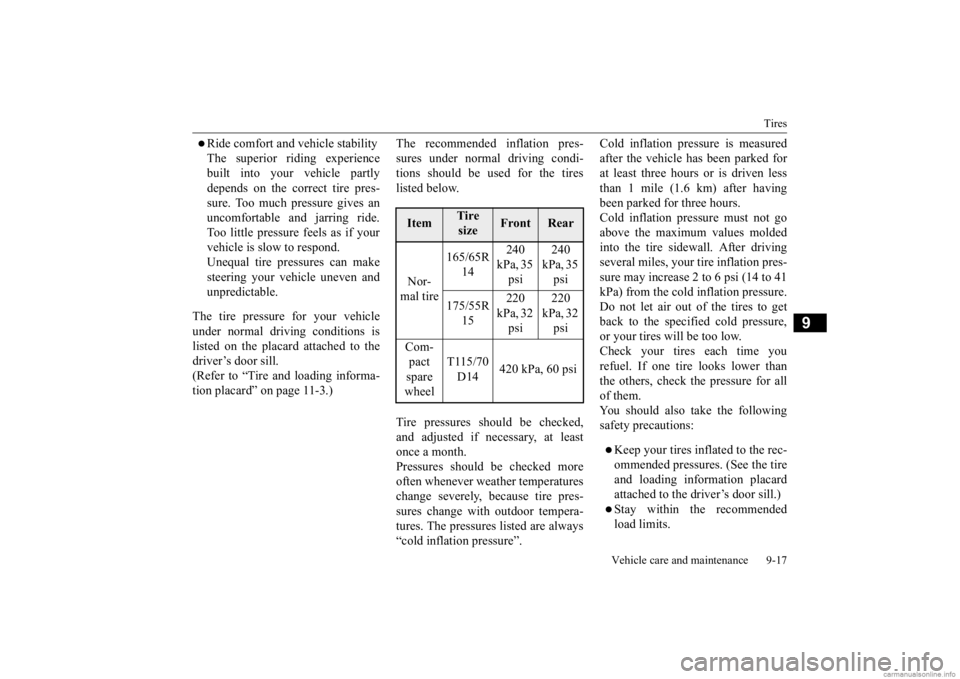
Tires
Vehicle care and maintenance 9-17
9
Ride comfort and vehicle stability The superior riding experience built into your vehicle partly depends on the correct tire pres-sure. Too much pressure gives an uncomfortable and jarring ride. Too little pressure feels as if yourvehicle is slow to respond. Unequal tire pressures can make steering your vehicle uneven andunpredictable.
The tire pressure for your vehicle under normal driving conditions is listed on the placard attached to the driver’s door sill.(Refer to “Tire and loading informa- tion placard” on page 11-3.)
The recommended inflation pres- sures under normal driving condi- tions should be used for the tires listed below. Tire pressures should be checked, and adjusted if necessary, at least once a month.Pressures should be checked more often whenever weather temperatures change severely, because tire pres-sures change with outdoor tempera- tures. The pressures listed are always “cold inflation pressure”.
Cold inflation pressure is measured after the vehicle has been parked for at least three hours or is driven less than 1 mile (1.6 km) after havingbeen parked for three hours. Cold inflation pres
sure must not go
above the maximum values moldedinto the tire sidewall. After driving several miles, your tire inflation pres- sure may increase 2 to 6 psi (14 to 41kPa) from the cold inflation pressure. Do not let air out of the tires to get back to the specified cold pressure,or your tires will be too low. Check your tires each time you refuel. If one tire looks lower thanthe others, check the pressure for all of them. You should also take the followingsafety precautions:Keep your tires inflated to the rec-ommended pressures. (See the tireand loading information placard attached to the driver’s door sill.)Stay within the recommended load limits.
Item
Tire size
Front
Rear
Nor- mal tire
165/65R
14
240 kPa, 35
psi
240 kPa, 35
psi
175/55R
15
220 kPa, 32
psi
220 kPa, 32
psi
Com- pact spare wheel
T115/70 D14
420 kPa, 60 psi
BK0284300US.book 17 ページ 2019年5月23日 木曜日 午後12時22分
Page 215 of 253
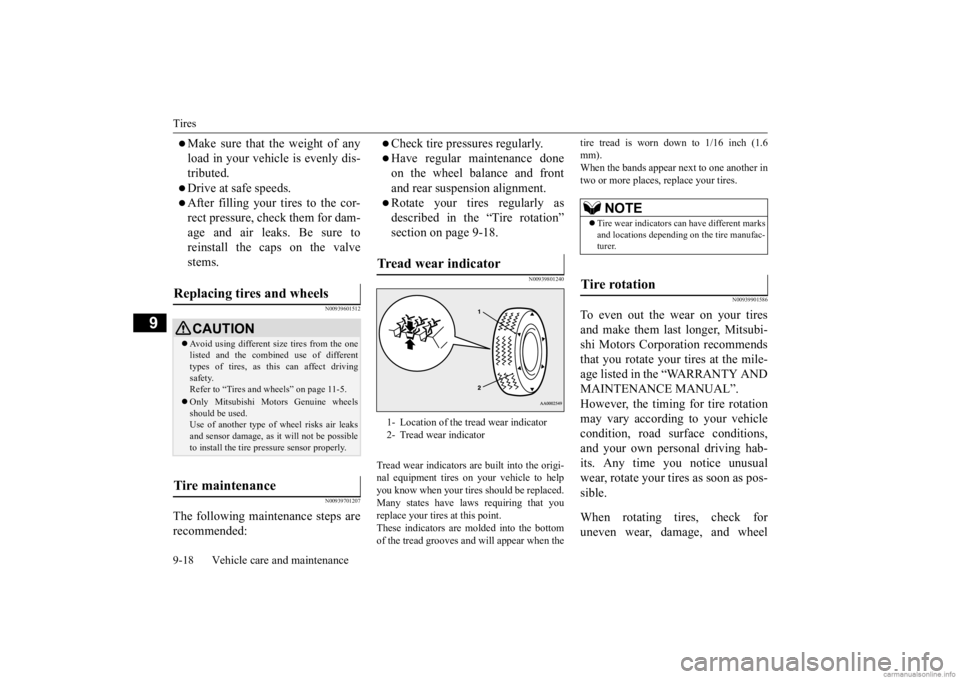
Tires 9-18 Vehicle care and maintenance
9
Make sure that the weight of any load in your vehicle is evenly dis- tributed.Drive at safe speeds.After filling your tires to the cor-rect pressure, check them for dam- age and air leaks. Be sure toreinstall the caps on the valve stems.
N00939601512 N00939701207
The following maintenance steps are recommended:
Check tire pressures regularly.Have regular maintenance done on the wheel balance and front and rear suspension alignment.Rotate your tires regularly as described in the “Tire rotation” section on page 9-18.
N00939801240
Tread wear indicators are built into the origi- nal equipment tires on
your vehicle to help
you know when your tires should be replaced. Many states have la
ws requiring that you
replace your tires at this point. These indicators are molded into the bottom of the tread grooves and will appear when the
tire tread is worn down to 1/16 inch (1.6 mm).When the bands appear next to one another in two or more places
, replace your tires.
N00939901586
To even out the wear on your tires and make them last
longer, Mitsubi-
shi Motors Corporation recommendsthat you rotate your tires at the mile- age listed in the “WARRANTY AND MAINTENANCE MANUAL”.However, the timing for tire rotation may vary according to your vehicle condition, road surface conditions,and your own personal driving hab- its. Any time you notice unusual wear, rotate your tires as soon as pos-sible. When rotating tires, check for uneven wear, damage, and wheel
Replacing tires and wheels
CAUTION Avoid using different size tires from the one listed and the combined use of different types of tires, as this can affect driving safety.Refer to “Tires and wheels” on page 11-5. Only Mitsubishi Motors Genuine wheels should be used. Use of another type of
wheel risks air leaks
and sensor damage, as
it will not be possible
to install the tire pressure sensor properly.
Tire maintenance
Tread wear indicator 1- Location of the tread wear indicator 2- Tread wear indicator
NOTE
Tire wear indicators ca
n have different marks
and locations depending
on the tire manufac-
turer.
Tire rotation
BK0284300US.book 18 ページ 2019年5月23日 木曜日 午後12時22分
Page 216 of 253
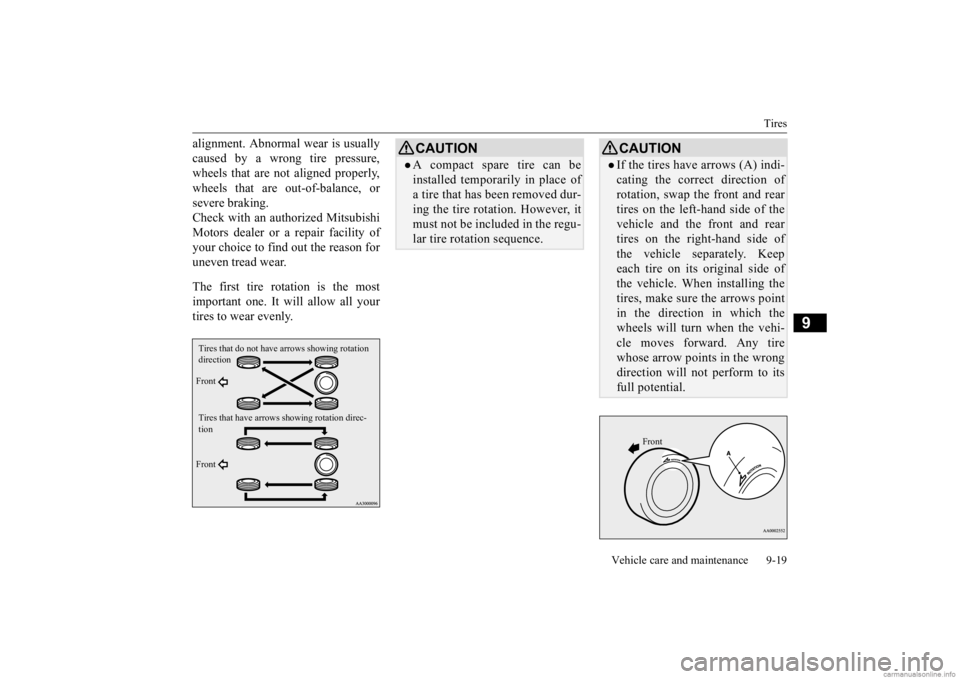
Tires
Vehicle care and maintenance 9-19
9
alignment. Abnormal wear is usually caused by a wrong tire pressure, wheels that are not aligned properly, wheels that are out-of-balance, orsevere braking. Check with an authorized Mitsubishi Motors dealer or a repair facility ofyour choice to find out the reason for uneven tread wear. The first tire rotation is the most important one. It will allow all your tires to wear evenly.Tires that do not have arrows showing rotation direction Front Tires that have arrows
showing rotation direc-
tion Front
CAUTIONA compact spare tire can beinstalled temporarily in place of a tire that has been removed dur- ing the tire rotation. However, itmust not be included in the regu- lar tire rotation sequence.
CAUTIONIf the tires have arrows (A) indi- cating the correct direction of rotation, swap the front and rear tires on the left-hand side of thevehicle and the front and rear tires on the right-hand side of the vehicle separately. Keepeach tire on its original side of the vehicle. When installing the tires, make sure the arrows pointin the direction in which the wheels will turn when the vehi- cle moves forward. Any tirewhose arrow points in the wrong direction will not perform to its full potential.
Front
BK0284300US.book 19 ページ 2019年5月23日 木曜日 午後12時22分
Page 217 of 253
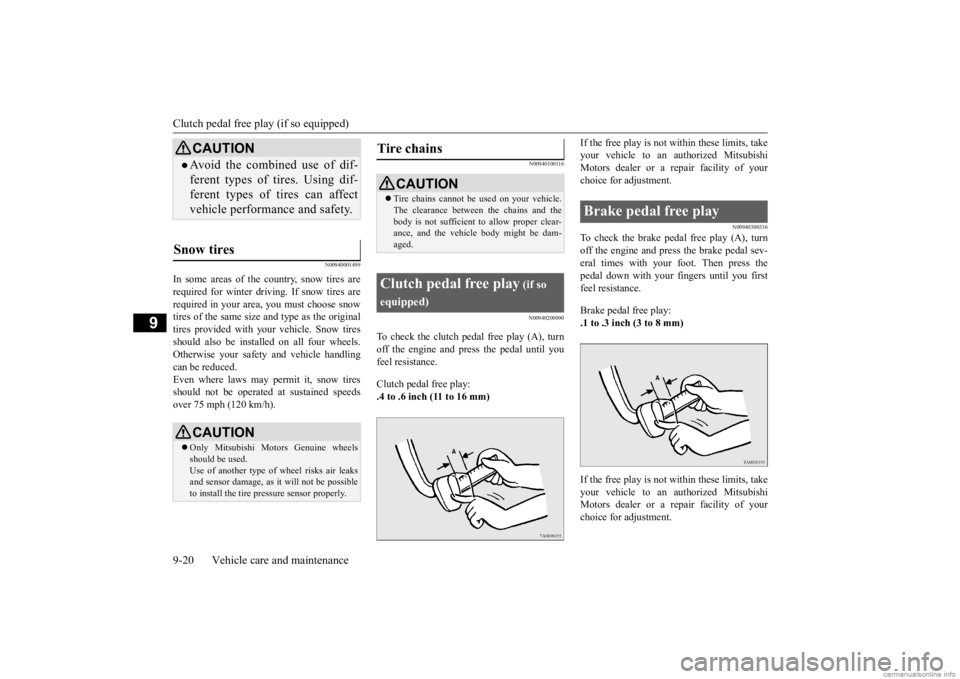
Clutch pedal free play (if so equipped) 9-20 Vehicle care and maintenance
9
N00940001499
In some areas of the country, snow tires are required for winter driving. If snow tires are required in your area, you must choose snow tires of the same size
and type as the original
tires provided with your vehicle. Snow tires should also be installe
d on all four wheels.
Otherwise your safety and vehicle handlingcan be reduced. Even where laws may permit it, snow tires should not be operated
at sustained speeds
over 75 mph (120 km/h).
N00940100116 N00940200090
To check the clutch pedal free play (A), turn off the engine and pr
ess the pedal until you
feel resistance. Clutch pedal free play: .4 to .6 inch (11 to 16 mm)
If the free play is not within these limits, take your vehicle to an authorized MitsubishiMotors dealer or a repair facility of your choice for adjustment.
N00940300336
To check the brake pedal free play (A), turnoff the engine and press the brake pedal sev- eral times with your foot. Then press the pedal down with your fingers until you first feel resistance. Brake pedal free play: .1 to .3 inch (3 to 8 mm) If the free play is not within these limits, take your vehicle to an authorized Mitsubishi Motors dealer or a repair facility of yourchoice for adjustment.
CAUTIONAvoid the combined use of dif- ferent types of tires. Using dif- ferent types of tires can affect vehicle performance and safety.
Snow tires
CAUTION Only Mitsubishi Motors Genuine wheels should be used.Use of another type of
wheel risks air leaks
and sensor damage, as
it will not be possible
to install the tire pressure sensor properly.
Tire chains
CAUTION Tire chains cannot be used on your vehicle. The clearance between
the chains and the
body is not sufficient
to allow proper clear-
ance, and the vehicle body might be dam- aged.
Clutch pedal free play
(if so
equipped)
Brake pedal free play
BK0284300US.book 20 ページ 2019年5月23日 木曜日 午後12時22分
Page 218 of 253
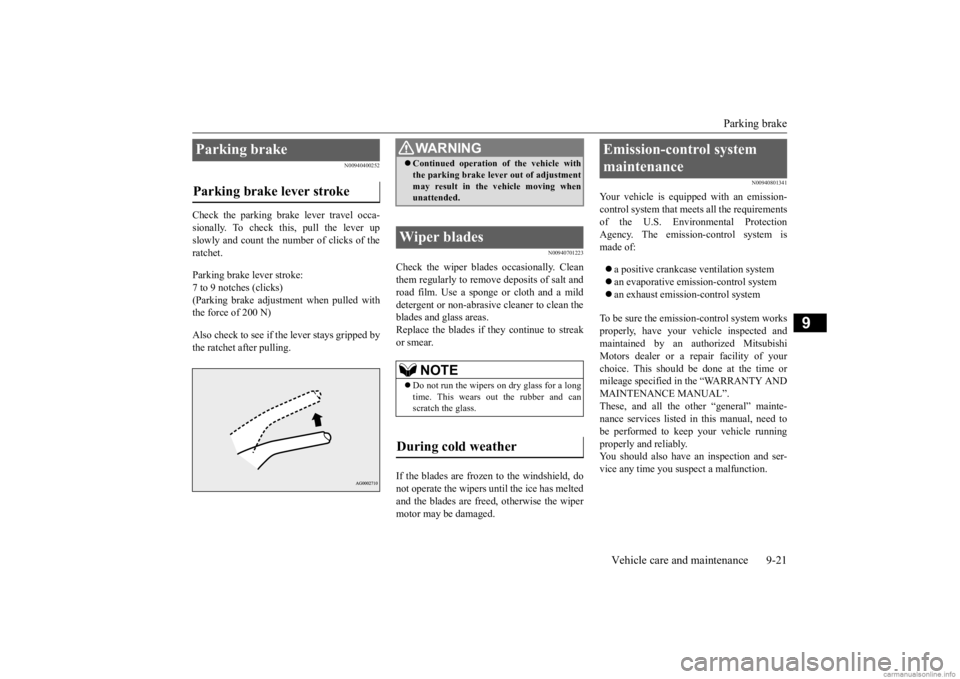
Parking brake
Vehicle care and maintenance 9-21
9
N00940400252
Check the parking brake lever travel occa- sionally. To check this, pull the lever up slowly and count the number of clicks of the ratchet. Parking brake lever stroke: 7 to 9 notches (clicks) (Parking brake adjustment when pulled withthe force of 200 N) Also check to see if the lever stays gripped by the ratchet after pulling.
N00940701223
Check the wiper blades
occasionally. Clean
them regularly to remove
deposits of salt and
road film. Use a sponge or cloth and a mild detergent or non-abrasive cleaner to clean theblades and glass areas. Replace the blades if th
ey continue to streak
or smear. If the blades are frozen to the windshield, do not operate the wipers
until the ice has melted
and the blades are freed, otherwise the wiper motor may be damaged.
N00940801341
Your vehicle is equi
pped with an emission-
control system that meets all the requirements of the U.S. Enviro
nmental Protection
Agency. The emission-control system is made of: a positive crankcase
ventilati
on system
an evaporative emis
sion-control system
an exhaust emission-control system
To be sure the emissi
on-control system works
properly, have your vehicle inspected andmaintained by an authorized Mitsubishi Motors dealer or a repair facility of your choice. This should be done at the time ormileage specified in the “WARRANTY AND MAINTENANCE MANUAL”. These, and all the other “general” mainte-nance services listed in this manual, need to be performed to keep
your vehicle running
properly and reliably.You should also have an inspection and ser- vice any time you suspect a malfunction.
Parking brake Parking brake lever stroke
WA R N I N G Continued operation
of the vehicle with
the parking brake leve
r out of adjustment
may result in the
vehicle moving when
unattended.
Wiper blades
NOTE
Do not run the wipers on dry glass for a long time. This wears out
the rubber and can
scratch the glass.
During cold weather
Emission-control system maintenance
BK0284300US.book 21 ページ 2019年5月23日 木曜日 午後12時22分
Page 219 of 253
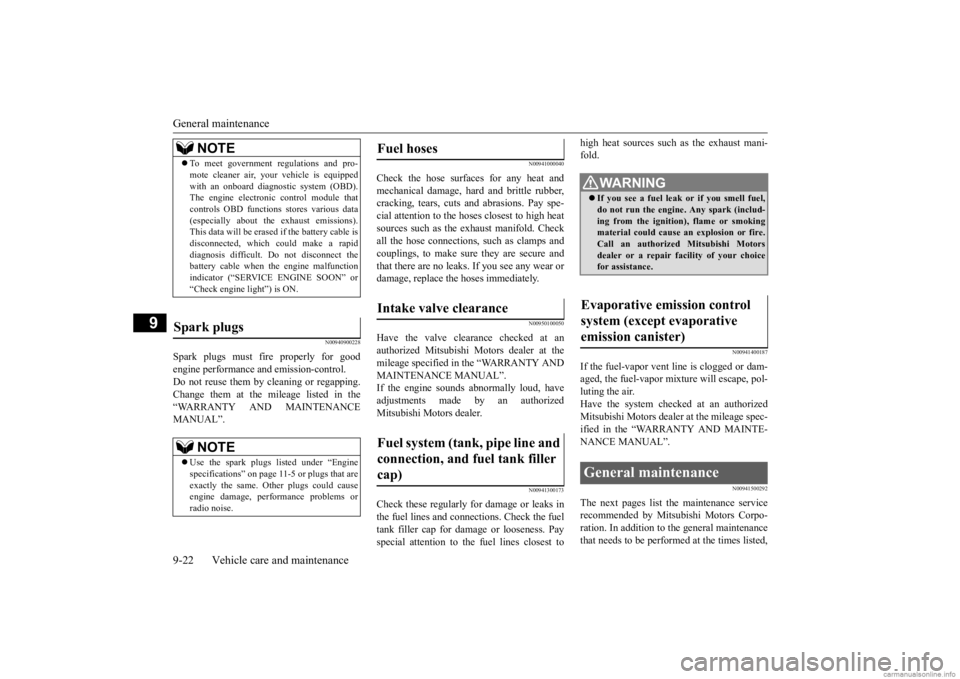
General maintenance 9-22 Vehicle care and maintenance
9
N00940900228
Spark plugs must fire properly for good engine performance
and emission-control.
Do not reuse them by cleaning or regapping.Change them at the mileage listed in the “WARRANTY AND MAINTENANCE MANUAL”.
N00941000040
Check the hose surfaces for any heat and mechanical damage, hard and brittle rubber, cracking, tears, cuts and abrasions. Pay spe-cial attention to the hos
es closest to high heat
sources such as the exhaust manifold. Check all the hose connections
, such as clamps and
couplings, to make sure
they are secure and
that there are no leaks. If you see any wear or damage, replace the
hoses immediately.
N00950100050
Have the valve clearance checked at an authorized Mitsubishi Motors dealer at the mileage specified in the “WARRANTY AND MAINTENANCE MANUAL”.If the engine sounds abnormally loud, have adjustments made by an authorized Mitsubishi Motors dealer.
N00941300173
Check these regularly for damage or leaks in the fuel lines and connections. Check the fuel tank filler cap for dama
ge or looseness. Pay
special attention to the fuel lines closest to
high heat sources such
as the exhaust mani-
fold.
N00941400187
If the fuel-vapor vent line is clogged or dam-aged, the fuel-vapor mixture will escape, pol- luting the air. Have the system checked at an authorizedMitsubishi Motors dealer at the mileage spec- ified in the “WARRANTY AND MAINTE- NANCE MANUAL”.
N00941500292
The next pages list th
e maintenance service
recommended by Mitsubishi Motors Corpo-ration. In addition to the general maintenance that needs to be performed at the times listed,
NOTE
To meet government regulations and pro- mote cleaner air, your
vehicle is equipped
with an onboard dia
gnostic system (OBD).
The engine electronic control module that controls OBD functions stores various data (especially about th
e exhaust emissions).
This data will be erased if the battery cable is disconnected, which could make a rapid diagnosis difficult.
Do not disconnect the
battery cable when the engine malfunction indicator (“SERVICE ENGINE SOON” or “Check engine
light”) is ON.
Spark plugs
NOTE
Use the spark plugs listed under “Engine specifications” on page 11
-5 or plugs that are
exactly the same. Other plugs could cause engine damage, performance problems orradio noise.
Fuel hoses Intake valve clearance Fuel system (tank, pipe line and connection, and fuel tank filler cap)
WA R N I N G If you see a fuel leak
or if you smell fuel,
do not run the engine. Any spark (includ- ing from the ignition
), flame or smoking
material could cause an explosion or fire.Call an authorized Mitsubishi Motors dealer or a repair fa
cility of your choice
for assistance.
Evaporative emission control system (except evaporative emission canister) General maintenance
BK0284300US.book 22 ページ 2019年5月23日 木曜日 午後12時22分
Page 220 of 253
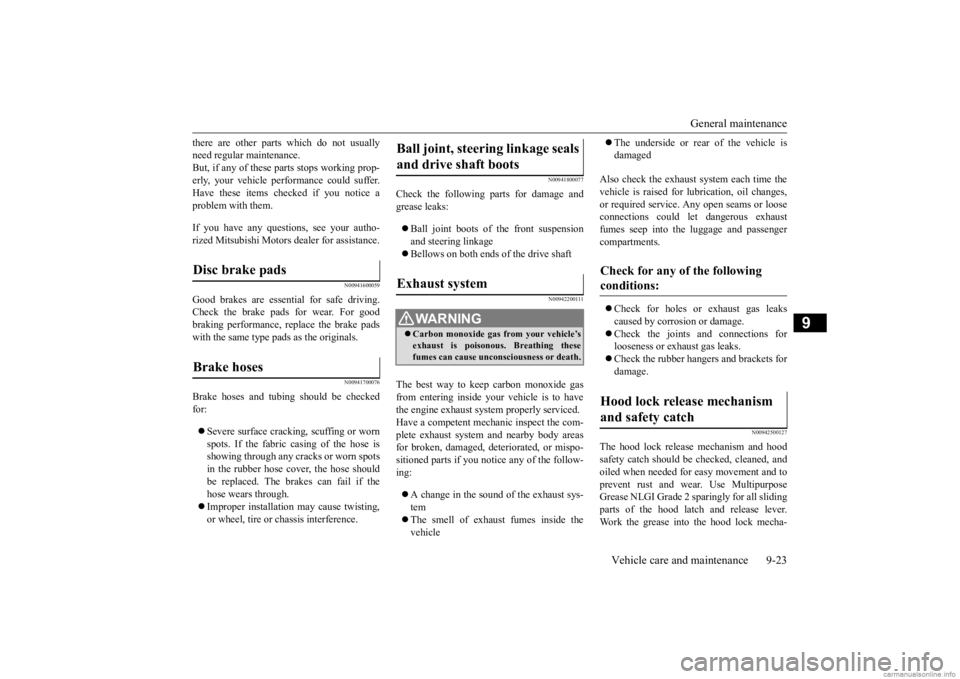
General maintenance
Vehicle care and maintenance 9-23
9
there are other parts which do not usually need regular maintenance.But, if any of these
parts stops working prop-
erly, your vehicle performance could suffer. Have these items checked if you notice aproblem with them. If you have any questions, see your autho- rized Mitsubishi Motors dealer for assistance.
N00941600059
Good brakes are essential for safe driving. Check the brake pads for wear. For goodbraking performance, replace the brake pads with the same type pa
ds as the originals.
N00941700076
Brake hoses and tubing should be checked for: Severe surface cracki
ng, scuffing or worn
spots. If the fabric casing of the hose isshowing through any cracks or worn spots in the rubber hose cover, the hose should be replaced. The brakes can fail if thehose wears through. Improper installation
may cause twisting,
or wheel, tire or
chassis interference.
N00941800077
Check the following parts for damage and grease leaks: Ball joint boots of the front suspension and steering linkage Bellows on both ends of the drive shaft
N00942200111
The best way to keep carbon monoxide gas from entering inside your
vehicle is to have
the engine exhaust syst
em properly serviced.
Have a competent mechanic inspect the com- plete exhaust system
and nearby body areas
for broken, damaged, deteriorated, or mispo- sitioned parts if you no
tice any of the follow-
ing: A change in the sound of the exhaust sys- tem The smell of exhaust fumes inside the vehicle
The underside or rear of the vehicle is damaged
Also check the exhaust system each time the vehicle is raised for l
ubrication, oil changes,
or required service. A
ny open seams or loose
connections could le
t dangerous exhaust
fumes seep into the luggage and passenger compartments. Check for holes or exhaust gas leaks caused by corrosion or damage. Check the joints and connections for looseness or exhaust gas leaks. Check the rubber hangers and brackets for damage.
N00942500127
The hood lock release mechanism and hood safety catch should be
checked, cleaned, and
oiled when needed for easy movement and to prevent rust and wear. Use Multipurpose Grease NLGI Grade 2 sp
aringly for all sliding
parts of the hood latc
h and release lever.
Work the grease into the hood lock mecha-
Disc brake pads Brake hoses
Ball joint, steering linkage seals and drive shaft boots Exhaust system
WA R N I N G Carbon monoxide gas
from your vehicle’s
exhaust is poisonous. Breathing thesefumes can cause unconsciousness or death.
Check for any of the following conditions: Hood lock release mechanism and safety catch
BK0284300US.book 23 ページ 2019年5月23日 木曜日 午後12時22分